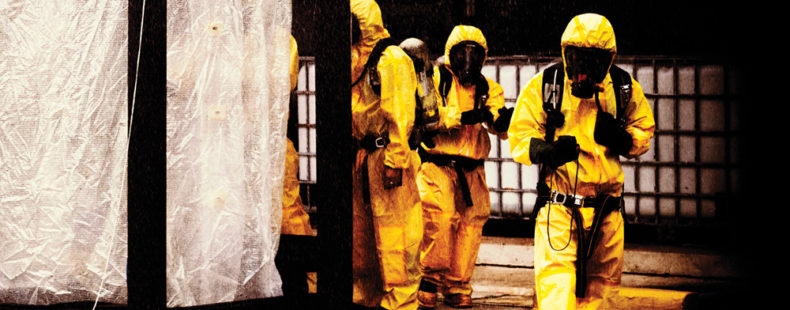The word chemical elicits strong reactions from many people. You’ve probably seen viral headlines over the past few years about “yoga mat chemicals” in your Subway sandwich bread or “toxic chemicals” in your mascara. Certainly, you’ve seen people online discussing the “dangerous chemicals” they believe are contained in vaccines.
When people see the word chemical, it tends to inspire fear, but should it?
What is a chemical?
A chemical is “a substance produced by or used in a chemical process,” such as how two molecules of hydrogen and one of oxygen bond together to form water, or H₂O.
First recorded in English in the 1500s, the word chemical, along with related terms like chemic and chemistry, comes from a Latin root, alchimicus, that also gives us alchemy. (This Latin word is ultimately a mix of Arabic and Greek sources.)
Alchemy
is “a form of chemistry and speculative philosophy practiced in the Middle Ages and the Renaissance and concerned principally with discovering methods for transmuting baser metals into gold and with finding a universal solvent and an elixir of life.” Not-so scientific stuff, though those methods did help give rise to chemistry as we now know it.
What do we mean when we use the word chemical today?
Scientifically speaking, everything that you can breathe, touch, see, and ingest is made of chemicals, because matter combines and changes to make up the physical word as we know it. Air is made of chemicals. Water is made of chemicals. Popular memes list the breakdown of chemicals in your everyday apple … and there are a lot of them.
Acetone, formaldehyde, isopropanol and CHEMICALS. Stay away!!!
Just kidding….these are the chemicals which make up an APPLE. 🍎 🍏 All food is made of chemicals. @joeschwarcz #OHEA19 pic.twitter.com/laMH3eaXFO— Dara & Erin (@How_To_Eat) March 23, 2019
However, when many people use the word chemical today, they aren’t talking about any old chemical like H₂O. (We tend to refer to that as a molecule or chemical compound.) Chemical in general has now narrowed—in a process some linguists call semantic deterioration—to refer to a substance considered unnatural or dangerous, particularly when it comes to food, drinks, and other household products. This narrowing was likely influenced by terms like toxic chemicals or chemical warfare. Yeah, nasty business.
Are chemicals actually dangerous?
Because everything is made up of chemicals, the presence of chemicals does not automatically make something dangerous. Moreover, in instances in which a chemical is potentially harmful, it’s often the dose, or “concentration,” of the chemical that determines the risk.
For instance, water is a chemical compound that we know is safe for human consumption; however, it’s toxic if consumed in excessive quantities. Drinking too much water can cause
hyponatremia
, “an abnormally low concentration of sodium ions in the blood” that causes brain swelling and is potentially fatal. Of course, knowing about this very rare condition doesn’t mean that we are afraid to drink water, because we understand what constitutes a safe amount of water to drink. (And, of course, none of us would be alive if we didn’t drink it.)
It’s also true that different chemicals carry different risks, depending on how they’re being used. Azodicarbonamide (ADA), the so-called “yoga mat chemical” that had everyone panicked in 2014, has been linked to serious respiratory issues by the
World Health Organization
. Nonetheless, NPR reported that over 500 food products contain ADA, and it’s used to maintain the texture of different kinds of bread.
So, what gives? The fact is, ADA can cause respiratory problems in factory workers who are handling massive quantities of it each day, but, in food production, the evidence shows that ADA poses no risk to consumers.
There are instances in which things we consume do contain chemicals in amounts that are considered dangerous. In January 2019, reports surfaced that many fruit juices contain detectable levels of arsenic. Heavy metals like arsenic can occur naturally in soil and water, or they may be introduced through the use of certain pesticides. While the US Food and Drug Administration (FDA) has proposed a limit on the amount of arsenic that can be present in food, Aparna Bole, a pediatrician on the American Academy of Pediatrics’ Council on Environmental Health, told
NPR
in January 2019: “We know there are no safe levels of exposure to these heavy metals.”
In the case of fruit juices, it seems there is a real potential danger people should heed. But, whether or not a chemical is dangerous almost always depends on the type of chemical, the amount, and how it’s being used. The presence of chemicals, or the word chemical, alone is not enough to suggest that we should be fearful.
So, why are we so afraid of the word chemical?
Our collective fear of chemicals didn’t spring up overnight. As our planet has become more polluted, our foods more processed, and misinformation on the internet more pervasive, the way we understand and interact with chemicals has changed.
The creators of fad diets tout the importance of eating “clean” and “natural” foods with only ingredients that you can pronounce. Celebrity parents publicly question the efficacy of vaccines and Western medicine. And, every other day, it seems, there’s a new, sensationalized article telling us what “toxic chemicals” are in our snacks, shampoo, sunscreen, makeup, soft drinks—you name it. The word chemical gets tacked on to reports to sway public opinion about certain products. And, while it’s important to know exactly what makes up our food, water, makeup, sunscreen, and even vaccines, are people only adding the word chemical to inspire fear and in turn a shift in public consumption?
Having access to more information is certainly not a bad thing, but it’s easy to get overwhelmed and difficult to know which sources to trust. Plus, the average consumer is not a trained scientist who knows how to interpret complex, technical data or who can weed out whether the chemicals reported are harmless or not. We can see this most clearly in the falling vaccine rates in the US, as more and more people insist that vaccines are full of dangerous chemicals even though scientists have stated otherwise.
But, our fear of chemicals also likely stems from too many true stories about how harmful chemicals have hurt people. Tobacco companies famously lied about the dangers of cigarette ingredients for decades, contributing to poor health outcomes for countless people. In Flint, Michigan, thousands of people were drinking lead-contaminated water for years before federal officials took action–and, even now, the cleanup process is still ongoing. More recently, exposure to a commonly used Monsanto weedkiller was found to be connected to a man’s cancer.
With stats like that, when we see the word chemical it always seems bad, no matter the actual facts.
Balancing the chemical equation
Given these very serious examples of how toxic substances have impacted people and communities, it’s not surprising that some might wonder what other dangers lurk in products they use on a daily basis. Nonetheless, the fear of chemicals also does real damage, like the outbreak of measles we’ve seen recently in the US.
Chemicals absolutely have the ability to cause harm, but the word chemical in and of itself is not a synonym for danger. It is important to understand this difference before our fears take over from reading one small scientific word.














